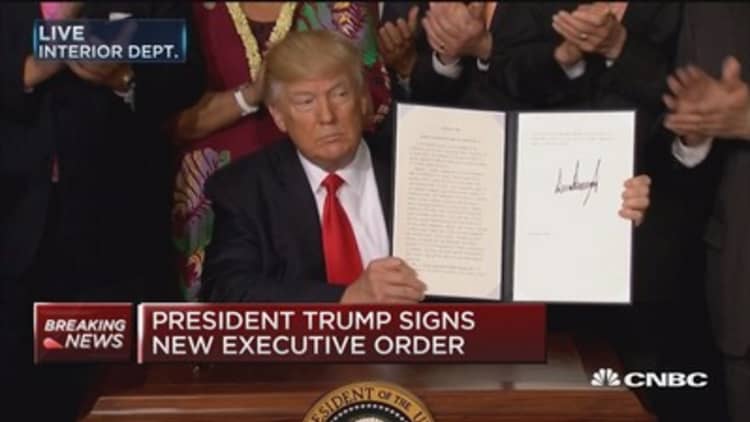President Donald Trump has pursued a business-focused agenda by vowing to cut regulatory red tape, a move that resulted in an Interior Department review that could change the designation of more than two dozen national monuments.
But the review has created a tug-of-war between industries like fishing, ranching and logging, arguing the creation of monuments comes at the cost of jobs, and the Main Street businesses that get foot traffic from visitors to the monuments.
"We'll look at what sectors were affected, plus or minus, and that will be part of the recommendation," Interior Secretary Ryan Zinke said in April when the executive order was announced, saying he recognizes both sides of the issue.
Since the window for public comments period opened Friday, more than 10,000 letters have been posted on the Interior Department's landing page. Some support the review; others support keeping the monuments as they are.
Take Oregon's Cascade-Siskiyou National Monument. In March, a forestry lobby sued the Interior Department for unlawful of expansion of the park, calling the restriction of federal timberlands "disastrous" for the Northwest economy and citing the loss of "thousands of family-wage forestry jobs." On the flip side, small businesses cite the Main Street impact of the monument; a hotel operator says the Cascade-Siskiyou has been "of great value" to its guests, and a couple running an area kid's clothing store says the monument "has only helped our local economy."

In Utah, the cattle industry continues to fight back against the designation of Grand Staircase-Escalante National Monument; it's the oldest and largest land monument Interior is currently reviewing. Because a president can singularly designate an area as a monument, the industry says the economic impact wasn't considered before the land designated for government use.
"There is no evaluation required for the president to do this, no economic or environmental study, just simply a stroke of pen," said Ethan Lane, the Executive Director of the Public Lands Council and the National Cattlemen's Beef Association.
But the group said it's seen the allocation of land for federal use cut the land available for grazing by two-thirds, forcing businesses to close, families leave the area due to lack of work and more than one school in the monument boundaries closed.
Yet the recreation industry, again, cites a boon.
"My company currently employs 15 full-time people in Kane County, Utah," wrote the unidentified owner of a company leading excursions into Grand Staircase-Escalante. "Outdoor recreation and tourism provides millions of dollars of sales and lodging taxes to the county."
Zinke visited Utah on a four-day listening tour in early May. "I'm an optimist," Zinke said during the visit. "After being on the ground for a few days and talking to people on all sides I think everyone has a lot more in common than previously thought."
A review of Utah's Bears Ears National Monument, which received a somewhat controversial designation without public input in 2016, is expected to conclude in early June. The comment window for feedback on the rest of the 26 monuments ends on July 10, with Interior taking up to four months to conclude its review.
The Katahadin Woods and Waters National Monument, spanning 87,563 acres, is the smallest of the 27 monuments on the Interior Department's list and opened just last year. Yet more than 50 public comments reference nearby Millinocket, Maine, a town with about 4,000 residents about 45 minutes from the monument that had been hit hard by the decline of the paper industry.
Marsha Donahue owns a Millinocket gallery that showcases local artists and has arranged expeditions in the monument to paint its landscapes. An artist who exhibits at the North Light Gallery told the Interior Department that the monument's opening has increased his sales at the gallery. Donahue, an activist supporting the area's 2016 designation, says economic optimism has taken root.
"People are sprucing up the front and the inside of their businesses, and there is much more of a feeling of hope," Donahue told CNBC in an e-mail. "We are all advertising like crazy."
Zinke told reporters at an April briefing at the White House that, in addition to receiving public input, he'd be consulting with state and local officials and congressional delegations before making any final decisions.
"I think the concern that I have and the president has that when you designate a monument, the local community that's affected should have a voice," Zinke said in April. "The little community, the loggers, the fishermen, those areas that are affected should have a say and a voice."
CNBC's Stephanie Dhue contributed to this report.
—By CNBC's Kayla Tausche. Follow her on Twitter: @KaylaTausche


